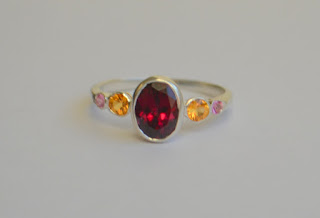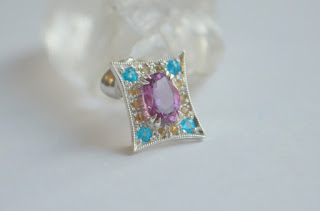Gem Setting Revisited
I have written about setting gems before, but in lieu of the fact that so much of my business is now custom, here are a few of the most important considerations worth having at your fingertips.
1. What metal should I use?
The softest metal is Sterling Silver, but setting costs are high in the US, so my personal view is that doing custom setting in the US in silver is a waste of your money. Gold is better. Yellow gold is the softest of the gold metals, white gold is the hardest, rose the most brittle. So for soft stones, yellow is best. If you have a soft(er) or brittle stone that you really don’t want to get busted and want to use a white metal, splurge on Platinum. That’s what I recommend for Paraiba tourmaline for instance. Platinum is softer than white gold.
Note, however, that in the US, most standard settings available only come in 14K yellow and white gold. Rose gold and also platinum are often special order and special orders are not refundable in the wholesale world, meaning that when I buy it I cannot return it.
2. What setting style is best?
If you want your stone to be kept safe during setting, use prong style. That is easiest to do and least risky to the stone. Sadly, if you want your stone to be safe after setting it, you want to bezel it, especially if it is a ring. Silver prongs fold easily but bend open easily too, I counsel against them for rings unless there is some protection around it, like a halo (my settings are designed with thicker prongs too). Bezel settings for faceted gems use the hammer setting method where the metal is literally hammered over the stone with a small electrical hammering tool (the ones for cabochons use thinner metals and can be folded without hammering, the problem there is that you need a very exact fit and that means most bezels have to be made by hand, which costs more). This won’t work for very soft stones in gold (kyanite, apatite, sometimes emerald), so you can be stuck with using prong settings. To help secure the stone, you might consider 8 prongs instead of four.
 |
| 4 Prong Setting |
 |
| Bezel Setting |
 |
| 8 Prong Setting |
An alternative to both that I use, but that requires more expertise, is a beaded setting, or pave. This is a kind of bezel setting (bezel on the outside) but little bits of metal are shoved over the gem to hold it down (so like prong setting). The beading tools are sharp so that’s a risk but the gem is very protected after wearing. My pave pieces are done by hand, so the “prongs” aren’t in the CAD. This has a more handmade look but that’s how more high end stuff is made and when you have a great setter (I LOVE mine), you will get a nicer result than the commercial look.
 |
| Pave Setting |
3. Are there other setting styles?
Yes, there is burnished or gypsy setting, which is like a bezel setting but into a flat surface, the metal is then rubbed over the stone. This cannot be done with anything over 3mm and it cannot be done with soft gems.
 |
| Gypsy Setting Photo from www.ashford.com |
There is channel setting. This involves bending channel wire (imagine a straw sliced in half) around a gem. That’s done by lazer because you have to solder the two ends together. It can take up to an hour a gem and is very expensive (my retail price is $120 a piece!). Channel setting works only for pendants and earrings because the back will poke out, but it offers a very delicate look. Gems with more than one corner can’t be channel set because the metal isn’t pliable enough. The corner is used for the soldering seam. So rounds, ovals, and pears work, not emerald or princess cuts.
 |
| Channel Setting |
4. I want to buy my own setting, what can I expect?
In the US market, expect to be restricted to 14K yellow or white gold and some silver (not much). Get prong settings for faceted stones because bezels have to be fitted very exactly and if you order online you won't have the gem on hand. Prong settings allow a little more give (.5mm at most). When in doubt, buy the larger prong setting, not the smaller one. For cushion gems, use round. For elongated cushions, use emerald settings because there are hardly any cushion settings available anywhere.
Specialty shapes: expect problems. Many shapes just require custom jobs. But if you have one you like, the cheapest way to go is doing a pendant and starting with a setting that can be adjusted a little (like narrowing down a pear to an elongated pear, or a trillion for an off shaped trillion).
And one final note on using old settings: most settings are made for diamonds and those are not as deep as colored stones for the most part. And since prongs get clipped to accommodate the gem, you may not have much room to work with. Prongs can also get brittle with age, and they can break upon or after resetting. So it may not pay to reset unless you have a more expensive ring. Don't reset if it is pave style or if you don't see enough prong or bead to put back over the stone.
And one final note on using old settings: most settings are made for diamonds and those are not as deep as colored stones for the most part. And since prongs get clipped to accommodate the gem, you may not have much room to work with. Prongs can also get brittle with age, and they can break upon or after resetting. So it may not pay to reset unless you have a more expensive ring. Don't reset if it is pave style or if you don't see enough prong or bead to put back over the stone.
